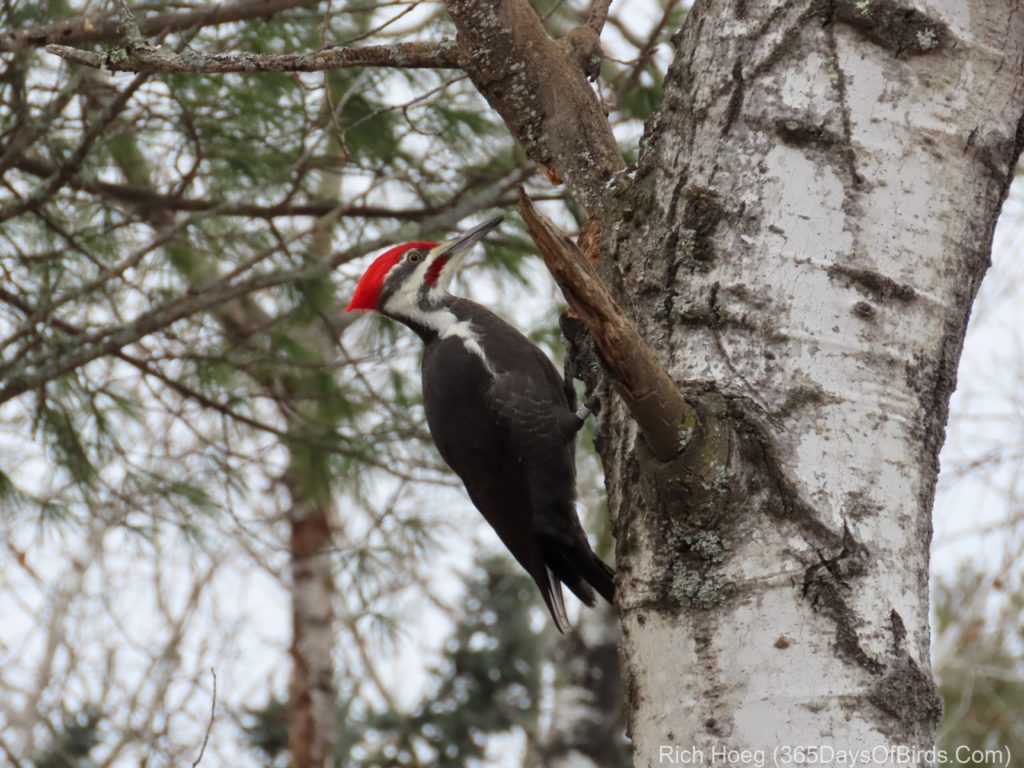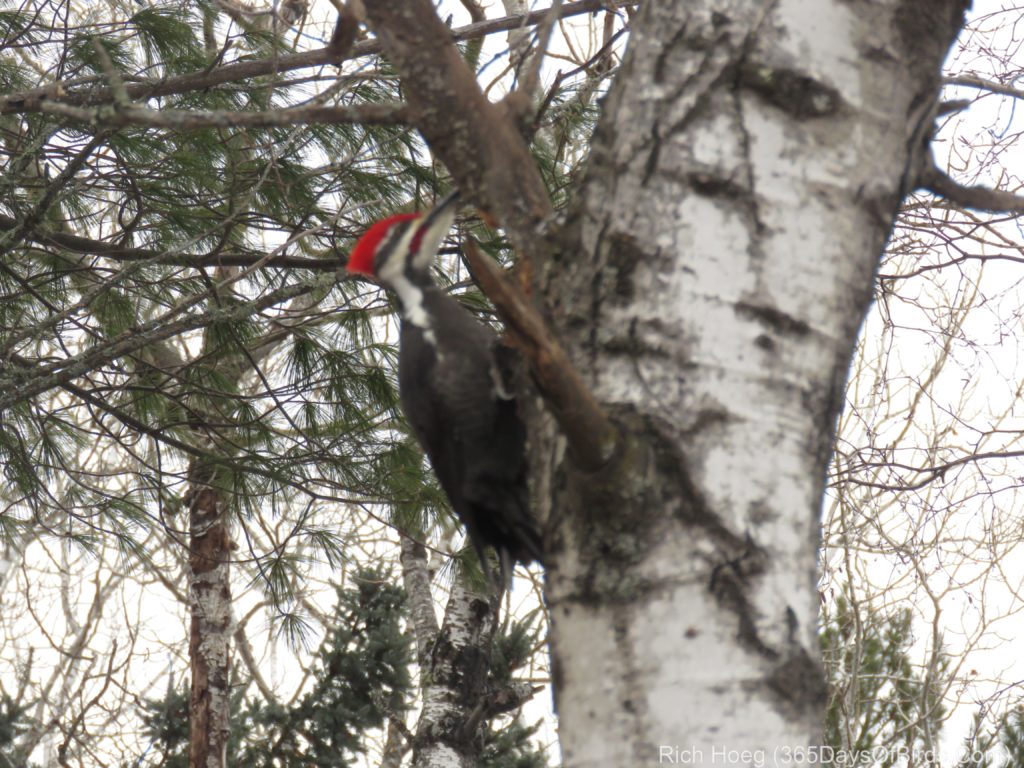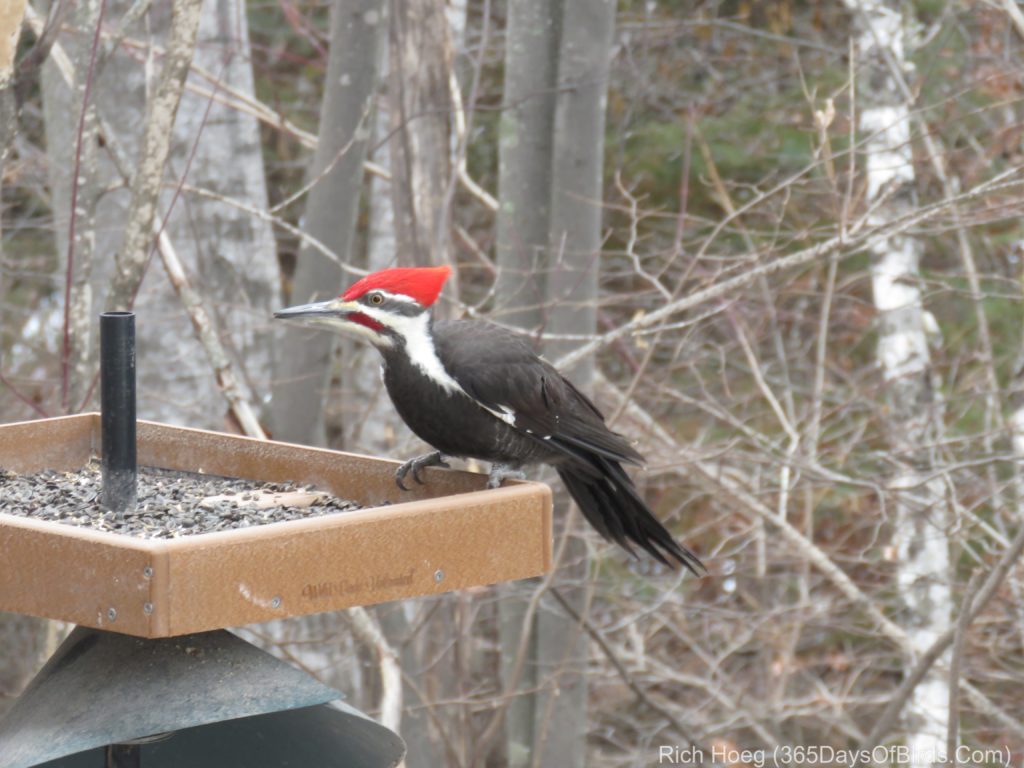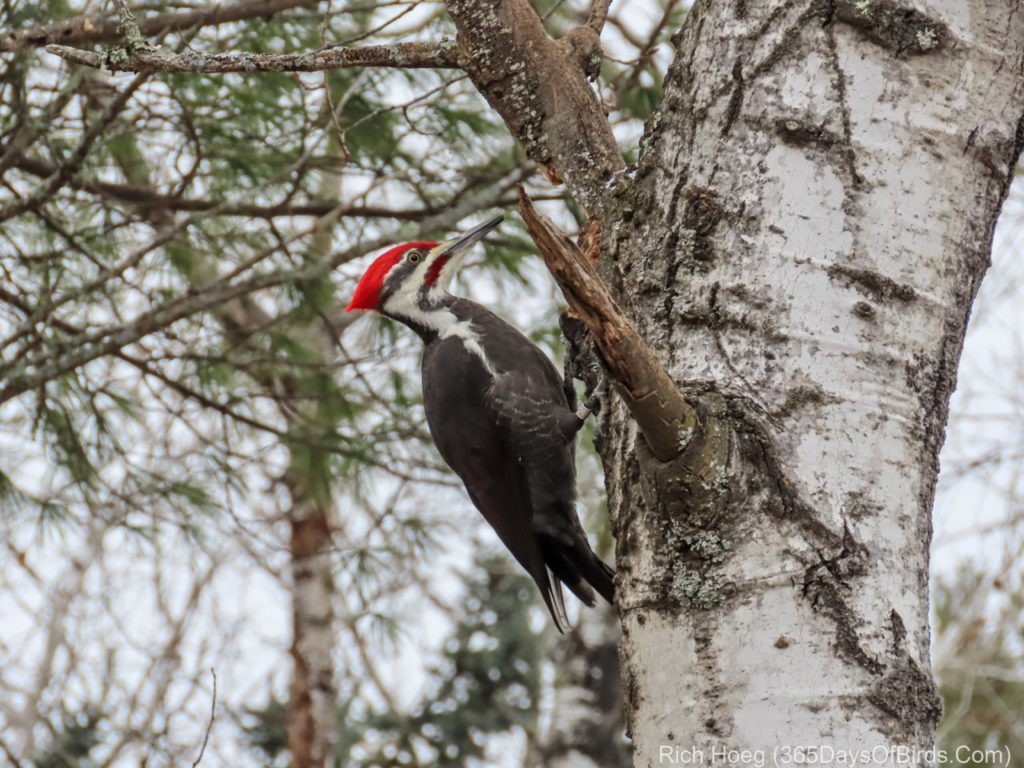I had not planned on writing this review today, Christmas Day. Our children and grandchildren don’t start arriving till tomorrow. Thus, Molly and I planned to spend this afternoon at the movie theater watching Mary Poppins Returns. Sold out! Thus, we are back home with some free time before supper.
Earlier today the male Pileated Woodpecker paid my yard a visit. He is a regular at my feeders and some of the dead trees in the yard. I knew this bird would hang around for a while, and give me the opportunity to take identical photographs with my SX60, and also with my new SX70. In summary I was dumbfounded in a positive way in terms how the Canon SX70 handled the low light compared to the SX60 I have owned for four years. This post includes the Canon SX70 and SX60 images … both right out of the camera and with some minor edits which I explain. As a fyi, I always use a monopod to help stabilize my photographs.
If you are interested in reading my original SX70 camera review, follow the link to my previous post. This review only compares the two cameras in terms of performance against each other. The other review reviews the camera in general. On with the review …
The weather conditions were blah … heavy overcast skies. A friend who was over at the house for Christmas brunch and myself both estimated the distance between me and the woodpecker as approximately twelve yards (he’s an ex football coach and should know that distance). I set the ISO at 200 for both the SX70 and the SX60 and used Aperture Priority. Note the HUGE difference in terms of shutter speeds between the two cameras. The SX 70 with identical Aperture Priority settings to the SX60 achieved a shutter speed 1/160th of a second. The SX60 could only achieve a shutter speed of 1/80th of a second. In addition the SX60 could not achieve focus. It was too dark.
Canon SX70 Aperture Priority: ISO = 200; Aperture = 5.6; Shutter Speed = 1/160th second
Photo #1 is directly out of my camera … unedited / no cropping
Photo #1 (same SX70 Image) was now opened in Camera Raw … following edits / no cropping
- Clarity +40
- Black +40
- Shadows +12
Canon SX60 Aperture Priority: ISO = 200; Aperture = 5.6; Shutter Speed = 1/80th second … no edits or cropping … not worth any effort … garbage photograph
Note: I took over 50 photos using burst mode … stopping ever 5 to 8 photographs to refocus and attempt to get a clean image. I could never get a focus lock with the SX60. The Pileated Woodpecker was in the same exact location relative to me.
Finally when the Pileated Woodpecker moved to my platform feeder to eat some corn, and the light was more directly upon it, I was able to achieve a focus lock. Although the conditions were heavy clouds, my earlier images were towards the sun’s position behind the thick clouds. The following SX60 image is unedited or cropped (directly out of the camera). The bird was more out in the open at this point, and the SX60 was now able to achieve a focus lock, but the shutter speed actually decreased to 1/25th of a second. For those of you who do bird photography, this speed is way to slow to reliable stop action on even a somewhat motionless bird. I was not able to take a photograph with my SX70 before the woodpecker flew away. Here is the SX60 image.
 Follow me, Rich Hoeg, on Instagram.
Follow me, Rich Hoeg, on Instagram.

P.S. to my recent comment: I enjoy bird photography, close-ups of small critters of almost any sort, and dramatic landscapes and generally appealing scenic views in natural surroundings. Recently I have enjoyed making relatively large color prints (13″x 19″ is my upper limit at present) and have found SX60 to be capable enough to allow some cropping when the IS is doing its job (I have IS on and hand-hold practically all the time, and am impressed by what I get from the best of the results).
I just became aware that there are menu settings in my SX60 which I hadn’t paid attention to earlier which attempt to address the over-exposed whites and under-exposed shadow areas, which seems like choices worth giving a try, at least. Otherwise, for subjects which are likely to produce washed-out highlights, exposing a bit less might help more than hurt.
I can’t say at this late date whether all the settings were identical in addition to the basic optical settings … ISO, Exposure Length, and Aperture, but after almost one year with the camera I am still convinced the digital processing is improved. As today’s cameras are now as much computers as mechanical devices, I believe a change of the operating system or sensor can make a huge difference. Thanks for your comment.
I have had a sequence of this camera series from the S5 IS up through the SX60 HS, with the dramatic increase in the zoom factor the primary incentive for upgrading, so with no obvious change in the lens in the SX70 HS and a relatively minor change in resolution, I have not yet found a reason to upgrade to the SX70. However, the information you give regarding the improved processing of the image is tempting me to look more closely at it.
Regarding the differences in the shutter speed used by the SX60 versus the SX 70 on the same subject, however, I can’t tell if you checked to make sure that all of the settings that are available through the cameras’ menus for the two cameras were the same. If they weren’t , that might explain some of your observed differences. Good site! Much appreciated!
Interesting, I’ve been wavering on whether to sell my SX60 and get the ’70. Think I will. The evf is a vast improvement and I guess that the new processor is making the improvements in operation that you mention.
Thoroughly enjoyed reading these reviews.
Hi Richard
A very interesting review, thank you. I’ve got the SX60 and have been waiting for the ‘70 for some time, only to be a little disappointed with some of the spec reductions and also the relatively high price, especially here in the UK. There are however some new features which are great and I can’t decide whether to upgrade or not. You obviously have, is it that much better than the ‘60 to make the cost worthwhile? Out of interest have you used the panorama feature? I’ve used similar on Panasonic cameras and can be useful.
Many thanks
Nigel
Nigel … the biggest difference by far for me in terms of the Sx70 compared to the Sx60 is its better performance in lower light. In terms of some of the other camera features including panorama, I have not tried them … Sorry. I use the Sx70 for bird photography, and my Sony A6000 for most everything else.
It is also important to note I never hand hold my Sx70 (or my Sx60). I tend to be at full zoom most of the time, and use a monopod to stabilize the camera.
Question? I also have both cameras. I love my sx60 and just recently started using the creative setting where the camera does the work and takes about 6 images with different effects. I do not find that feature on my sx70. Also the sx70 does not stay on the feature of taking several photos at one time and I have to keep going back into the menu settings every time I turn the camera in. The sx60 remained on even if the camera shut off.
Denise: I never use the special settings modes because I wish to have full control over my camera, which means I am always in Aperture, Shutter, or Manual Modes. However, “if” continous mode is available for the picture option you select, it will be available by pressing the quick select button on your camera (main button in the center back of your camera … toggle through options, pages 41 and 42 of manual), and then selecting continous. Challenge yourself to take full control of your camera. You can always accomplish everything the “special modes” provide, except with more control for specific lighting conditions. When you are not certain what ISO, aperture, and exposure modes to utilize, Google the words “camera settings” and the type of photograph you wish to take … like “moon”, “fireworks”, etc.
If you have not already done so, I suggest downloading the full pdf manual from the Canon web site. Very helpful.
Rich
I have a SX60 and have loved a lot about it. I do a fair amount of photography for work, and have been really pleased at the results with a camera that is easier to pack and more ‘all purpose’ than a DSLR. I have been annoyed at two things though. One is the lack of a ‘bulb’ setting for shutter speed so I could just hold it open as long as I want for night shots. The second is the really annoying way the manual focus works with the up/down arrows instead of the index finger operated dial. Is the control for manual focus any better on the SX70? And, are there any better options for night photos than the SX60 has? (actually, the lack of easy panorama photos and GPS data are also annoying, but far less so!)
Sent you a response via email. Will post an answer here within the next 48 hours.
Looking forward to more. Try some things not moving with different textures, simply for IQ comparison. Great work so far!
The SX60 pic has focussed, but on the foliage and tree trunk behind the bird.
No idea why though!
Den
Something doesn’t compute. I’m not familiar with the difference in optics between the two cameras, but I thought they were basically the same, i.e. 65X FL, f/3.4-6.5. If you were shooting at the same focal length with both cameras and the same ISO why the big difference in shutter speeds? Enquiring minds want to know…
John: Your question is most reasonable. Quite frankly I can not give a scientific answer, but have noticed many times of the past week that the newer Sx70 performs better in lower light. I know the SX70 has a new sensor and operating system. Remember, although cameras are definitely mechanical, they are also computers which process light and put it on the simm card using a jpg algorithm. Thus, although the focal lengths were almost the same for both sets of photographs, how the light was processed was quite different. I worked at an engineering research and development center for almost 30 years. One thing I learned is the end result very much depends upon the entire system as a whole, not just the individual parts.
For instance, I also own a Sony A6000. I made this purchase because my research indicated Sony manufactured greater than 50% of the sensors for all camera manufacturers. I wanted a good low light camera for night photography, and it made sense to me that the company which made the sensor, and understood all a particular design features down to a micro silicon level would be able to in theory design a better overall system around the chip / sensor.
There was a tiny difference between the focal lengths, but so small as to not account for the dramatic difference in shutter speed. As noted I would love to technically explain the difference, but I would need to be a hardware / software / firmware engineer all rolled up into one with an understanding of Canon’s technology down to a minute level. That is beyond me; I just presented results.
One more comment … at a high level the optics are the same, but under the hood there are big differences. Gets back to my comment that in the year 2018 digital cameras are more computers than mechanical devices.
Have you tried to read the band number with a spotting scope?
Would not even need a spotting scope. My pileated woodpeckers are very tolerant of me as I am Mr. Food. Shall have to do that with my Nikon Monarch binoculars.
I loved that reply.